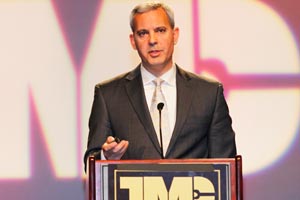ATA’s Osiecki Outlines Trucking’s Legislative, Regulatory Outlook

NASHVILLE, Tenn. — The trucking industry is continuing to pursue policy goals in a long-term highway bill, including a permanent fix to the suspended hours-of-service restart provision, American Trucking Associations’ Dave Osiecki said.
The industry also wants to get bonus depreciation for equipment purchases — which was extended through the end of 2014 — made permanent; is seeking improvements to the federal Compliance, Safety, Accountability program; and wants a new freight program, said Osiecki, ATA’s chief of national advocacy.
“This country does not have a freight-specific plan,” Osiecki said here in a Feb. 17 keynote speech at the Technology & Maintenance Council’s 2015 annual meeting, where he outlined key issues facing the industry.
“The freight strategic plan that [the Department of Transportation] is working on is somewhat meaningless unless there’s funding behind it,” he said. “The trucking industry knows where freight bottlenecks are, and we want the freight program to focus highway dollars on those to keep our trucks moving.”
He also cited several key federal regulations, including a greenhouse-gas and fuel-economy rule by the Environmental Protection Agency and National Highway Traffic Safety Administration.
“EPA and NHTSA’s fuel-economy rule is a big deal for this industry,” he said, adding that the phased-in approach will step up in its next round of regulations.
“There are lots of things going on behind the scenes . . . what we really don’t want to see is a technology-forcing standard for the engine,” he said.
The Obama administration — like other Democratic or Republican administrations have done historically in their third years — will “do as many rulemakings and finalize them as they can,” he said, adding that “the pipeline will slow, almost to a halt” in its final year in office in 2016.
ATA also has petitioned the government for a standard for speed-limiters, which Osiecki said already are used by about 70% of the trucking industry, and the federation has not taken a legislative initiative to address trucking’s shortage of drivers, but plans to.
That could include “lowering the age, conditionally,” of interstate truck drivers to 18 from 21, “as long as we have really good training and oversight monitoring of those folks,” Osiecki said. “Not every 18- and 19 year-old person should be behind the wheel of a truck, and we get that, but we think we can do that responsibly.”

